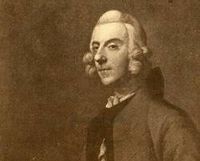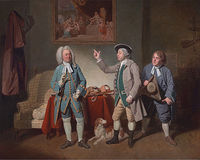Annotation:Love in a Village (1): Difference between revisions
No edit summary |
No edit summary |
||
| Line 22: | Line 22: | ||
</font></p> | </font></p> | ||
<p><font face="garamond, serif" size="4"> | <p><font face="garamond, serif" size="4"> | ||
''Printed sources'': '''Harding's All Round Collection''', 1905; No. 14, p. 5. | ''Printed sources'': Hime ('''Forty Eight Original Irish Dances Never Before Printed with Basses'''), Dublin, 1803; No. 3. '''Harding's All Round Collection''', 1905; No. 14, p. 5. | ||
<br> | <br> | ||
<br> | <br> | ||
Revision as of 20:14, 26 April 2018
Back to Love in a Village (1)
LOVE IN A VILLAGE [1]. AKA and see "New Bath Whim," "Spell (The)," "Trip to Bedford House." English, Reel (4/4 time). C Major (Harding, Vickers): D Major (Rook). Standard tuning (fiddle). AABB. The title "Love in a Village" may have derived from a popular 1762 comic opera of the same name [1] by Thomas A. Arne and Isaac Bickerstaff (1735-1812), which has been called "the most popular comic opera of the eighteenth century." It was also the first of its kind--a play with music--although in the 18th century the term 'comic opera' was not often distinguished from 'ballad opera', notes Peter A. Tasch (The Dramatic Cobbler, 1972).

Critic William J. Lawrence writes:
Comic opera had its origin at Covent Garden in December 1762 with Bickerstaff's 'Love in a Village', which, in spite of the fact that it presented a patchwork plot set to patchwork music, attained a success and a longsustained popularity unequalled save the 'The Beggars Opera'.

There were 42 songs in Love in a Village, five written specifically for the opera by Arne. Samuel Howard (1710-1782) contributed two. The remaining music was compiled from previously written works by fourteen composers, including Arne. The melody may have predated Arne's opera for there are cognate English dance tunes printed within the same decade called "New Bath Whim" in John Johnson's Twenty Four Country Dances for the Year 1765 (London), and "Trip to Bedford House" in Twenty Four Country Dances for the Year 1766 (London: R. Bride). In Scotland, both Robert Bremner and the Gows published the tune under the title "Spell (The)." Under the title "Love in a Village [1]" the tune appears in American musician Henry Beck's German flute MS of 1786, in Cumbrian musician John Rook's 1840 copybook collection, and in Northumbrian musician William Vickers' 1770 music manuscript collection [2]. Various dances to set to the tune appear in American copybooks of the late 18th century; a similar one was entered into both Nancy Shepley's (Pepperell, Mass., c. 1795) and Asa Willcox's (Hartford County, Conn., 1793) manuscripts, while a different dance is contained in the publication Gentleman's and Lady's Companion (Norwich, Conn., 1798).
Source for notated version:
Printed sources: Hime (Forty Eight Original Irish Dances Never Before Printed with Basses), Dublin, 1803; No. 3. Harding's All Round Collection, 1905; No. 14, p. 5.
Recorded sources: Gourd Music 110, Barry Phillips and Friends - "The World Turned Upside Down" (1992).
